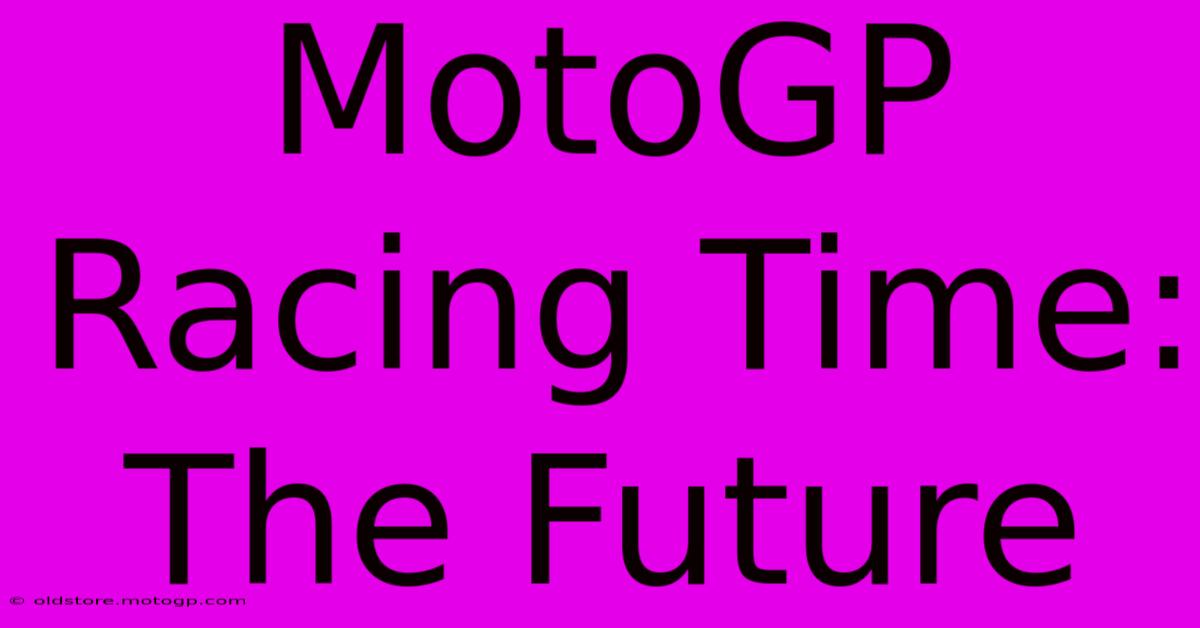MotoGP Racing Time: The Future

Table of Contents
MotoGP Racing Time: The Future of Speed and Technology
MotoGP, the pinnacle of motorcycle racing, is constantly evolving. The roar of the engines, the breathtaking speeds, and the nail-biting competition captivate millions worldwide. But what does the future hold for this exhilarating sport? This article delves into the exciting advancements and potential changes shaping the future of MotoGP racing time.
The Ongoing Quest for Faster Lap Times
The relentless pursuit of faster lap times is a core element of MotoGP. Teams and riders are constantly pushing the boundaries of technology and human performance. This pursuit isn't just about bragging rights; it directly impacts the overall spectacle and excitement of the races. Faster lap times translate to:
- More Overtaking Opportunities: Close racing and frequent position changes are what keep fans engaged. Faster speeds, within safe parameters, can create more opportunities for thrilling overtakes.
- Increased Excitement: The sheer speed and precision of MotoGP riders are already awe-inspiring. Improvements in technology and rider skill only amplify this excitement.
- Technological Innovation: The pressure to shave milliseconds off lap times drives innovation in engine design, aerodynamics, and tire technology. This benefits not only MotoGP but also the broader motorcycle industry.
Engine Technology: The Heart of the Beast
Engine technology plays a crucial role in determining lap times. While MotoGP has implemented regulations to control engine power and emissions, there's still significant room for optimization. We can expect continued advancements in:
- Engine Mapping and Electronics: Sophisticated engine management systems will allow for even finer control of power delivery, maximizing acceleration and efficiency throughout the lap.
- Lightweight Materials: The use of advanced materials like carbon fiber and titanium continues to reduce overall bike weight, resulting in improved handling and acceleration.
- Aerodynamics: Streamlined fairings and aerodynamic aids are constantly being refined to reduce drag and improve stability at high speeds.
The Human Element: Riders and Their Skills
While technology plays a vital role, the human element remains paramount. MotoGP riders are elite athletes, pushing their physical and mental limits with each race. The future will likely see:
- Enhanced Rider Training: Advanced training techniques, including data analysis and simulator training, will help riders hone their skills and optimize their performance.
- Improved Physical Conditioning: The physical demands of MotoGP are immense. Riders will continue to focus on enhanced fitness regimes to withstand the G-forces and maintain peak performance.
- Strategic Racecraft: Race strategy and tire management are increasingly crucial in determining the outcome of races. We can expect to see even more sophisticated race strategies implemented in the future.
Sustainability and the Future of MotoGP
The impact of motorsports on the environment is a growing concern. MotoGP is actively working to reduce its environmental footprint. Expect to see:
- Sustainable Fuels: The transition towards more sustainable fuels, such as biofuels and synthetic fuels, will become increasingly important.
- Reduced Emissions: Stricter regulations on emissions will continue to push manufacturers to develop cleaner and more efficient engines.
- Eco-Friendly Technologies: The incorporation of eco-friendly materials and manufacturing processes throughout the sport will become a priority.
The Spectators' Experience: A Seamless Blend of On-Track and Digital
The fan experience is also evolving. Expect more immersive viewing experiences using:
- Virtual Reality and Augmented Reality: These technologies will enhance the fan experience by offering unprecedented access to the races.
- Enhanced Data Visualization: Real-time data feeds and analysis will provide viewers with deeper insights into the performance of riders and machines.
- Interactive Fan Engagement: Improved online and digital platforms will enable fans to actively engage with the sport and with each other.
Conclusion: The future of MotoGP promises a thrilling blend of cutting-edge technology, elite athleticism, and a commitment to sustainability. Faster lap times, innovative technologies, and a focus on the fan experience will continue to drive the evolution of this captivating sport. The quest for speed and innovation will undoubtedly ensure that MotoGP remains a global phenomenon for years to come.

Thank you for visiting our website wich cover about MotoGP Racing Time: The Future. We hope the information provided has been useful to you. Feel free to contact us if you have any questions or need further assistance. See you next time and dont miss to bookmark.
Featured Posts
-
Experience The Adrenaline Ex Factory Bikes
Feb 22, 2025
-
Avoiding A Moto Gp Crash Expert Tips
Feb 22, 2025
-
American Moto Gp Riders Conquering The Track
Feb 22, 2025
-
A Nail Biting Finish Who Won Yesterdays Grand Prix
Feb 22, 2025
-
Become A Legend Own A Moto Gp Bike
Feb 22, 2025
